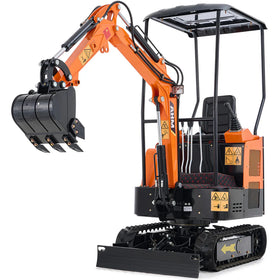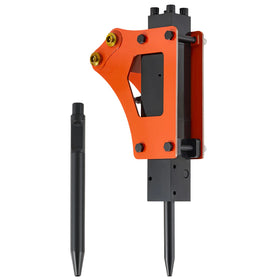Once mini-excavator tracks start failing apart, the damage can quickly spread to other expensive components like sprockets, idlers, and rollers, and can cause your machine to derail completely.
Moreover, changing mini excavator tracks isn't just about saving money on mechanic bills. It's about keeping your machine running efficiently and avoiding downtime when you're in the middle of a big project.
The good news is that track replacement isn't rocket science: with basic mechanical skills and some guidelines, you can handle this yourself.

Signs It Is Time To Change Mini Excavator Tracks
There are several signs to indicate that it might be time to change the tracks on your mini excavator. Worn or damaged tracks can reduce traction, strain your machine, and lead to costly downtime, so recognizing the signs early is crucial.
Here’s a quick summary of the signs that it’s time to change your mini excavator tracks:
1. Deep cracks, cuts, or missing rubber chunks weaken the track and reduce safety.
2. If the tread is shallow, uneven, or deformed, traction and stability will be poor.
3. Visible internal cords mean the rubber has worn too thin and the track is structurally compromised.
4. If your machine slips often, especially on soft ground, the tracks may be too worn.
5. If the track keeps coming off or derails during use, it's likely stretched or damaged.
6. Unusual vibrations or clunking sounds may point to uneven wear or internal breakdown.
If you notice any of these issues, it's time to inspect your tracks closely and consider replacing them.
How to Change Mini Excavator Tracks Step-by-Step
What You Need
- Before you start, gather your gloves, safety glasses, and steel-toed boots.
- You'll also need at least one helper - this isn't a one-person job.
- Make sure you're working on flat, stable ground away from traffic and other hazards.
- Have the following tools ready: a 19mm wrench, grease gun, pry bars, and socket wrenches.
- Most importantly, engage the safety lever on your excavator to prevent accidental movement.
Step 1: Lift the Excavator
The first step to changing mini-excavator tracks is getting the machine off the ground safely.
- If your excavator has a blade, push it down into the ground at the rear, then push the boom and bucket down at the front to lift the entire machine.
- For excavators without blades, position the boom and bucket to one side of the machine and push down until that side lifts off the ground.
You'll be working on one track at a time.
Step 2: Release Track Tension
Locate the grease valve access hole in the center of the track frame. Using your 19mm wrench, carefully remove the grease valve.
Grease will spray out as the tension releases, so wear safety glasses and keep your face away from the valve. As the grease drains, you'll see the track begin to loosen.
On newer machines, the idler will retract automatically. On older excavators, you might need to help it along by using a pry bar to walk the track off the sprocket.
Step 3: Remove the Old Track
Once tension is released, work the old track off the idler wheel first, then lift it off the rear sprocket. Tracks are heavy - this is definitely a two-person job.
Take your time and don't rush it.
Step 4: Install the New Track
Here's where knowing how to change tracks on a mini excavator correctly becomes crucial. All excavator tracks are directional - they have a V-shaped tread pattern that must face the correct direction.
The V-shape should point toward the front idler when you look at the track from the side. As the track travels under the excavator, the V will point toward the rear sprocket, helping to push mud and debris outward for better traction.
Lift the new track over the rear sprocket first, then work it onto the front idler.
Step 5: Restore Track Tension
Knowing how to tighten tracks on a mini-excavator properly is also critical for performance and longevity.
- Thread the grease valve back into the access hole and tighten it securely. Clean any debris from the grease fitting area.
- Using your grease gun, pump grease into the valve until the track achieves proper tension. You want about ¾ to 1 inch of sag between the track and the bottom roller.
Don't over-tighten as this causes premature wear.
Step 6: Test and Adjust
Lower the excavator back to the ground and test the tracks by running them forward and backward for about 30 seconds.
Check the tension again and make final adjustments if needed.
Explore Quality Mini Excavator with Solid Tracks
When you're investing in new mini excavator tracks or shopping for a new machine, quality matters. That's where AHM's mini excavator lineup really shines - these machines are built with durability and reliability in mind.

AX-12B - The Budget-Friendly Workhorse ($5,999.99)
The AX-12B with its 13.5 HP Briggs & Stratton engine delivers exceptional value without compromising on track quality. The 2,138 lb operating weight puts less stress on tracks, extending their lifespan, while the 69-inch dig depth handles the serious work.
AX-16 Series - Power and Versatility ($8,599.99 - $9,399.99)
Step up to the AX-16 series for 23 HP of power with an enhanced track system designed for demanding applications. The available swing boom and retractable undercarriage options provide versatility while maintaining track integrity.
AY-25 Series - Professional Grade Performance ($25,999.99 - $26,599.99)
When you need maximum power and reliability, the AY-25 series delivers with 25 HP Perkins diesel engines and a professional-grade track system.
Frequently Asked Questions (FAQ)
How do I know when it’s time to replace mini excavator tracks?
Look for signs such as visible cracks, tears, excessive wear on the track surface, track slipping or derailment, and reduced traction. Also, track tension that cannot be properly maintained is a sign of wear.
What tools do I need to replace the tracks?
Common tools include a socket wrench set, grease gun, pry bars or chisel bar, an open-end wrench, and safety equipment like gloves and goggles.
Can I replace just one track, or should both be replaced at the same time?
It’s best to replace both tracks at the same time to ensure even wear and optimal performance. Replacing only one may cause uneven wear and reduce the new track’s lifespan.
How do I release track tension?
Usually, there is a grease valve or grease fitting that you loosen to let the grease out, which releases the tension in the track to make removal easier.
Can I do the track replacement myself, or should I hire a professional?
With proper tools, safety precautions, and a helper, many operators can replace tracks themselves. However, if unsure or the tracks are heavy, professional assistance is recommended for safety.
What maintenance can prolong the life of mini excavator tracks?
Regular cleaning to remove debris, maintaining proper track tension, avoiding sharp turns on hard surfaces, and inspecting for damage routinely will help extend track life.
Conclusion
Understanding when and how to change mini excavator tracks is essential for any owner. The key is staying ahead of the problems by monitoring track condition regularly and replacing them before they fail.
Don't wait until tracks are completely worn or damaged, as this leads to expensive damage to other undercarriage components.
With the right AHM mini excavator and proper knowledge, you can keep your machine running efficiently for thousands of hours.








